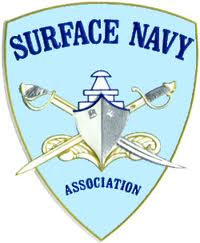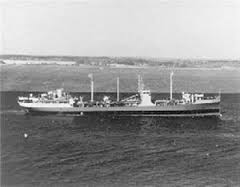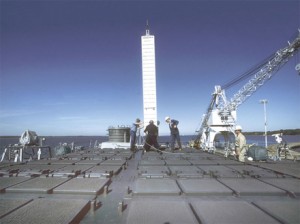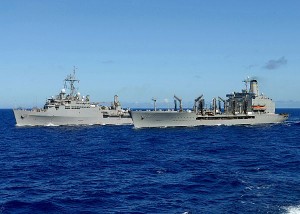 After Chief of Naval Operations Admiral Greenert has spent a year giving stump speeches that, in large part, highlighted the future contributions of civilian-manned ships operated by the Military Sealift Command (MSC) (the AFSB, MLP and JHSV), one might think that the Surface Navy Association (SNA) would get the message and give the humble ‘ole MSC (America’s unrecognized third-largest Navy) a little bit of love at the SNA’s annual convention this week.
After Chief of Naval Operations Admiral Greenert has spent a year giving stump speeches that, in large part, highlighted the future contributions of civilian-manned ships operated by the Military Sealift Command (MSC) (the AFSB, MLP and JHSV), one might think that the Surface Navy Association (SNA) would get the message and give the humble ‘ole MSC (America’s unrecognized third-largest Navy) a little bit of love at the SNA’s annual convention this week.
And, given that this year’s SNA meeting is set to focus on the Navy’s Pivot to the Pacific, where, you know, uninterrupted logistical support might just, oh, happen to be an important factor in controlling the biggest stretch of open water on the planet, one might, again, think it appropriate to highlight the MSC.
But a single glance at the agenda for the Surface Navy Association’s annual conclave reveals that the MSC–for all the contributions these gallant civilian mariners make in keeping surface combatants ready to fight–is almost entirely ignored.
The snub is unfair. The SNA makes a particular attempt to recognize the Coast Guard, America’s Second Navy. The Coast Guard gets their Cutterman’s call, a presentation, and a few token spots on panels and such, while the 10,000-person MSC gets little more than a booth (paid for by MSC funds, I’m sure) in a low-trafficked section of the conference hall. (You know, in the caves over by the Naval History and Heritage Command).
I shouldn’t be so upset. I mean, maybe NAVSEA will let MSC give a booth brief or something. As a consolation prize. And maybe one or two people will show up.
MSC: The Rodney Dangerfield Navy
 This sort of “can’t get no respect” snub from the surface warfighter community is nothing new. MSC’s low status was firmly on display at last year’s SNA conclave, when Rear Admiral Mark Buzby, a grizzled surface warrior who was ending his career as Commander of the U.S. Military Sealift Command, was forced to wait in line with the hoi polloi for a microphone after a Littoral Combat Ship panel discussion. When Buzby finally got to the microphone, he said something like, “Hi, for those of you who don’t know me, I run the Military Sealift Command, and we are, like you guys, introducing a fast aluminum ship to our fleet. Um…any way we can work together?”
This sort of “can’t get no respect” snub from the surface warfighter community is nothing new. MSC’s low status was firmly on display at last year’s SNA conclave, when Rear Admiral Mark Buzby, a grizzled surface warrior who was ending his career as Commander of the U.S. Military Sealift Command, was forced to wait in line with the hoi polloi for a microphone after a Littoral Combat Ship panel discussion. When Buzby finally got to the microphone, he said something like, “Hi, for those of you who don’t know me, I run the Military Sealift Command, and we are, like you guys, introducing a fast aluminum ship to our fleet. Um…any way we can work together?”
The Admiral’s comment brought down the house, but it was a touching example of just how little regard Surface Warriors pay to their logistics brethren. Today, to the Surface Navy, the MSC is not seen as a critical element in “Keeping the Navy Ready to Fight–Tonight!” but viewed as more of a floating UPS, a colorless part of the sea-routine whose crucial contributions are fated to go unrecognized until that one unlucky day missiles transform all the regional support ships into greasy oil slicks.
Some of the disrespect of naval logistics is an inevitable consequence of not being part of the action. Nobody writes gallant stories about logistics, and we’d far rather celebrate Fleet Admiral’s Nimitz’s victories in the Pacific than ponder how his service in Fleet Oiler USS Maumee (AO-2–see pic) may have made him better appreciate the logistical fleet train he built and used to support his dominance of the Pacific theatre.
 Surface Warriors have always short-changed logistical support. Colliers were ignored until after the Great White Fleet had the unenviable indignity of being forced to use colliers from rival navies. Tankers were slow to enter the fleet, and fleet support ships built for World War II went largely un-replaced and were used (and used and used) until well after the Cold War ended.
Surface Warriors have always short-changed logistical support. Colliers were ignored until after the Great White Fleet had the unenviable indignity of being forced to use colliers from rival navies. Tankers were slow to enter the fleet, and fleet support ships built for World War II went largely un-replaced and were used (and used and used) until well after the Cold War ended.
Fleet support ships are traditionally the last to get built upon development of a threat, and the first to get cut under budget pressure.
But even though fleet support ships and the wider fleet support mission traditionally lacked respect in the wider mechanized Navy, large auxiliaries were still grudgingly tolerated and even incorporated into the Surface Warrior’s path towards higher command. Until relatively recently, a good sprinkling of fleet commanders like, say, former CNO Mike Mullen, would emerge despite garnering sea time aboard humble auxiliaries. And, in addition, an enormous number of naval personnel served on these ships. Those auxiliaries and unlucky sailors aboard still counted–they were NAVY, after all. They had representation in the Fleet and within Fleet leadership.
But that’s all changed.
In the eighties and nineties, some smart, green-eyeshade type decided it would be a great idea to save money by outsourcing the Navy’s auxiliary fleet to the civil-service. And thus, the MSC was born. Guns and self-defense equipment were stripped from the logistical support vessels, logistic ship manning was ramped down, and civilians took command of the vessels….And logistics moved one step farther from the Surface Warrior’s consciousness.
Today, it is kind of a rude shock to realize the majority of the logistical support fleet has been outside of the mainstream Navy for, what? Two generations now? And now, without many friends in the war-fighting community, those humble logistical elements are too often overlooked. They are overlooked in modern wartime tactical planning and other activities (how closely is China targeting our T-AOs anyway?), and their doctrine is, I fear, sketched out by officers lacking first-hand experience within the logistics fleet. Making matters worse, most of our current crop of future leaders were weaned on operations within (or around) the Arabian Gulf, where spares were a helo flight away and refueling simply a matter of a quick port call.
You Can’t Engineer Logistics Away:
Other factors have been at play to further decouple the auxiliary fleet from the surface Navy’s consciousness. Warship crews have shrunk, while, in turn, naval combatants have gotten larger–meaning that ships can go farther without requiring resupply. Small ships, with their comparatively more demanding resupply schedules, have been virtually eliminated from the arsenal.
 The role of auxiliaries in resupply of surface combatants has particularly been impacted by the emergence of the VLS cell. With guns, ammunition resupply was vital for surface warships. And back when we engaged in surface strike engagements where an enormous amount of shells were used in either shore bombardment or anti-aircraft defense, commanders needed ammunition on a regular basis.
The role of auxiliaries in resupply of surface combatants has particularly been impacted by the emergence of the VLS cell. With guns, ammunition resupply was vital for surface warships. And back when we engaged in surface strike engagements where an enormous amount of shells were used in either shore bombardment or anti-aircraft defense, commanders needed ammunition on a regular basis.
That has changed. Today, the VLS cell is the main gun for virtually all the surface fleet. And since the Navy has fallen wholeheartedly into the “one salvo and win” school of warfighting, VLS resupply at sea has been discounted, and–as I have written before–it remains an unsolved, orphan problem.
This is going to get worse. As projectiles continue to shrink and a Navy eyes energy-oriented weapons like lasers and railguns, there will be an ever-greater temptation to discount logistical support. But barring a wholesale embrace of nuclear power–or a means to transform seawater into energy–the Navy will still need fuel in enormous amounts. Demand is growing–Since 2004, the amount of fuel disbursed by the Combat Logistics Force fleet has grown by about 30%, to about 556 million gallons in 2012. That demand is gonna rise and keep rising even if a few JP-5-hungry CVNs go away.
And there’s combat. Resupply in a contested ocean is a lost art. The reason fleet auxiliaries demanded so many people was because the Navy, back in the day, put a premium of minimizing alongside time. Getting fueled and rearmed fast meant survival. But, for the past twenty years the Navy surface leadership has been raised in the Arabian Gulf, a secure wonderland where we own the sea, the air and underwater domain. We could afford leisurely alongside experiences.
In the Pacific, these times are gone and will never return.
Outside of immediate combat support, the personnel-hungry maintenance and support aspects of the fleet train have been privatized or eliminated. And the results…well….Think of this essay after more careers are ground up in the Glenn Defense Marine Asia scandal. Tenders would have helped detect and mitigate the damage.
Navy: Ignore MSC At Your Own Peril:
For all the casual disrespect served to the logistical support services, the lean and mean MSC has grown by about seven percent over the past decade, while the Navy has shrunk by 20%. And with the Navy pondering which missions to cut, the MSC is in the happy position of discovering just what they can do with their newer platforms, while the legislature is happily handing America’s newest, most efficient and cost-effective Navy more and more missions. In effect, the distinction between MSC’s civilian mariners and the Navy’s costly sailors is dwindling.
In turn, the distinction between civilian platforms and naval platforms is also disappearing. Sometime soon, a President, facing a regional crisis, will turn to his commanders and demand to know, “Where’s an ASFAB and our JHSVs?”.
We are not the only Navy out there blending civilian and military roles and platforms. As China blends their rag-tag maritime militia into front-line activities and uses the Coast Guard and Fisheries boats for sea control, it is getting sillier and sillier to allow Title 10 to constrain a ship’s mission. And if we take the CNO’s adage “It’s payload, not platforms….you a-strategic idiots” (addition by the editor) to heart, then we need to accept the idea that any ship can serve a military purpose, and realize it is increasingly foolhardy to constrain a mission due to the type of crew aboard.
Without getting into details, this distinction between USN personnel and the civilian MSC mariner is getting more and more contrived. It must be solved.
The Way Ahead:
 To help reconcile and rekindle interest in the MSC’s logistical role and help avoid strategic/operational oversight or a future fight between the civil mariners and our sailors, I suggest the following:
To help reconcile and rekindle interest in the MSC’s logistical role and help avoid strategic/operational oversight or a future fight between the civil mariners and our sailors, I suggest the following:
- Make the MSC Command a career billet rather than a career-ending one. Add younger officers to the MSC and provide a career path for them.
- Embrace the blend. Put hybrid crews aboard USNS ships NOW, and give them hybrid warfighting missions and get to work on resolving Title X disputes now.
- Embrace modularity. Make the addition of comms and shipboard self-defense equipment and other items a regular practice (particularly in the Pacific), and continue developing ships (or subsystems) that can easily incorporate the addition of capability.
- Embrace (and fund) MSC flexibility. Let MSC have the operational flexibility it needs to experiment, while keeping some of the Navy’s more persnickety rules governing warfighters and warfighting platforms at arm’s length.
- Give MSC some added back-office support.
- Recognize MSC Mission Creep. Be conscious that the MSC is a “just-in-time” oriented organization, and that it lacks sufficient surge capability that may be needed in wartime. Give the MSC a sufficient number of platforms to support contingencies and MSC mission creep.
- Realize that resupply in a contested sea is a lost art. Recognize that the Navy has spent 20 years focusing on uncontested Arabian Gulf operations, where friendly ports and access to fuel and logistical support was a relatively easy thing.
- Get the Coast Guard to use MSC assets, darn it! Sell them on forward logistics, and encourage them work forward and buy into the MSC mission-set.
- And, yeah, get MSC some time of their own at SNA.
In closing, the 10,000 person MSC cannot continue being America’s “Rodney Dangerfield” Navy. The MSC deserves respect. Time is short. The MSC’s integration challenges really must be addressed. If action isn’t taken soon, some cost-cutting legislator someplace will use the MSC’s cost effectiveness as a sole basis to justify the devolution of combat missions to the MSC, transforming the MSC into nothing more than a means to outsource combat duties to a cheaper labor pool. And when that happens…goodness. Forget challenge of fighting in the Pacific–America’s various Navies will be too busy fighting each other.

{ 17 comments… read them below or add one }
First, I have no real expectation that SNA would highlight the MSC fleet, SNA for all intent is a trade show, and the modernization budget for the MSC family of ships is not one that elicits large interest, for the cost of Lockheed Martin’d display, you could probably upgrade an LMSR with a pendulating Crane system.
Second: What did surprise me was the lack of attention given to adaptive force package concepts. If you have been listening to the CNO for the last year, then that is where the train is taking us. Rather than an integrated ACB 12 system for AEGIS that will cost billions, the Navy is looking for a modular UAV system that could embark on something like a JHSV or MLP. I remember about 5 years ago where every other display touted its energy saving capability following Sec Mabus remarks regarding energy. that effort regarding payloads was missing this year.
MSC is partly to blame, recent remarks from MSC indicate they understand the future of payloads for their platforms, but they need to be a louder voice in touting future potential if they want a bigger booth at SNA
As a former MSC deck officer, I have to disagree with a few points made in the above article.
#1: Hybrid crews – While this may seem like a viable option and good way to cut costs by turning a supply vessel into a shooter, I can’t say much for hybrid crews. The OPs departments I’ve worked with have been fantastic and are an essential bridge between the Navy and MSC IMO, but in regards to having a USN CO at the Conn with MY license on the chopping block, its simply unacceptable. This is one of the reasons I decided to leave. If I’m on the bridge and the CO runs the ship aground coming into San Diego and we spill fuel, he’ll get a desk job, and I’ll go to jail. Leave MSC to professional mariners and let the Navy do their job.
That brings up the same point that GoM guy brought up, MSC is F****d six ways to Sunday when it comes to personnel. I’ve personally been involved in each situation he described, hopelessly overdue, pulled from training, and denied a higher license position to fill a “critical vacancy,” which just happened to be the breaking point. If they don’t make serious serious changes to the way they do business, it’s only a matter of time before the system breaks down. The people in the office seem to forget that they are there to work with mariners, without mariners, they don’t have a job. There needs to be incentive to stay with the outfit (leave, pay, leave, competent shoreside counterparts, and leave), otherwise, they’ll be training 75-100 new officers a year to fill the spots that the rest of us leave when we go down to the GoM to work on supply boats and make the same amount of money in half the time.
#2 Back-office support? I’m not sure what’s meant by this, but I’ve seen the office operations on both sides of the States PAC and LANT as well as MSCFE. Office support needs to come in the form of a consulting company coming through and trimming the tremendous amount of fat: rewarding performers with higher pay and more responsibility and cutting ties with the low lifes that make Sailor’s lives miserable. MSC needs to be consolidated and revamped, adding more people will do nothing but screw things up even more.
Generally, I would argue that MSC and the Navy are separate for a reason and need to remain so. SWOs are experts in their field: warfare… and I’ll never try to take down an enemy destroyer. Likewise, mariners are expert sailors, and they don’t need active duty sailors instructing them on their profession. You ask for it, and MSC will get it for you. The Chief above is right, keep the navy on the other side of the probe and high line. We all know that the Navy would CEASE TO OPERATE if it weren’t for MSC.
An interesting article. My wife sails with MSC while I work in the US GoM on platform supply vessels. Friends I’ve sailed with or went to school went worked for MSC The stories I hear from them, I’m not really sure how she still puts up with the Navy and MSC shore support and I understand why none of my shipmates stayed with MSC. I took leave of the navy for a reason and it is no wonder MSC can’t keep a hold of personnel. While my customer is no picnic either, I get paid far better to put up with their inanities.
The wife had nothing but bad things to say about her hybrid ship as well. It seems to me the concept would require an acknowledgement that the Navy Captain and the MSC Chief Mate are going to have to work more like partners or as Masters & Chief Engineers elsewhere in the merchant marine do than a pure superior/subordinate relationship Navy Captains are used to, as well as an acknowledgement by the Navy guys that the Navy hasn’t churned out true ship masters in decades and know nothing of seamanship, navigation, shiphandling, etc.
MSC, in order to sustain itself, is also going to have to get a handle on its personnel issues. Inadequate personnel numbers that lead to months overdue for relief. Silly-short relief time: no where else in the Merchant Marine do you get one month off for four on and it hurts the quality of the pool of personnel which come to MSC. Most new recruits see it as a stepping stone to DP quals or tankerman or something else that lets them take their time and quals and go somewhere else where they are better paid and appreciated. Shore side MSC has got to be the most retarded bunch of morons I have ever heard of. Scheduled training tomorrow? Nope! Off to such-and-such ship, which is not leaving for two more weeks. Oh, and by the way, make sure you check your email that next day for the chew out from the very same person on why the hell you missed training they scheduled for you.
Nope. The Navy doesn’t know how good it has it with MSC running their logistics and that’s saying something considering how messed up MSC operations are.
I’m a 33 year mariner; 8 years Navy, 10 years Commercial and 16 years MSC, currently a Boatswain. IMHO, the biggest issue from a deck-plate perspective is getting our Naval colleagues to listen to us when we try to help. We possess the old-dog knuckle dragger skills of UnRep and Cargo Handling/Movement to a degree that is just not present on the shooter side of the rig.
The one thing more than any other that causes me and my colleagues on the MSC ships to tear (what’s left of) our hair out is when we willingly and patiently communicate how and why a procedure must be done to insure mission accomplishment with everyone still standing at the finish line and we are roundly and soundly ignored.
We respect the navy’s technological warfighting ability. All we ask is that you respect our seamanship and cargo handling experience and capability to the same degree.
As to the other points, while many are good I agree with both the CHENG and MASTER that “navalizing” our side of the equation has more downside than up. Does ho we look really matter when measured against what we can do?
Sorry about the grammar. Typing on my phone.
Lets talk about sea time. In the past 7-1/2 years I’ve been underway (the propeller spinning) for 6 years. Is there any numbers out there that show just how much a Civmar has been sailing compared to a lieutenant on a combatant ship?
Also, I’ve asked many transient passengers, many new, fresh from Great Lakes naval base in Waukegan IL, that they’ve never heard of MSC. How about Navy personnel departing the Navy… I’ve also heard that we don’t get any say at TAP services. ( transition office of some sort? Where is the MSC recruitment booth?
I do feel for the MSC, being in the NAVY for 20 yrs I was in supply department and we were not given the respect that other department were given. although without Supply division no repair supplies, no ships store, no where to eat, no barber shop or vending machines, and no laundry. All logistics and supply get no respect from the commands and fleet officers.
YES! I’d like to write about some of this, and, if you are amenable to it, I’d like to chat with you a bit more about this. Shoot me an email directly, will ya? craig.hooper@nextnavy.com
Good article with a lot of VERY good points. I don’t agree with some of the recommendations and some are all ready in place to one degree or another
What really needs to happen is a recognition within the surface force that MSC is PART of the navy and the CIVMARs really do know what we’re doing! How many times have our N4s or N3s tried to reinvent a logistics wheel when the Master on the nearby T-AO, AKE or AOE has done it before or knows how to do it more efficiently but wasn’t asked? Too often, we (MSC afloat personnel) know as much or more about the capabilities or limitations of a ship than that ship’s own crew because we’ve refueled, rearmed or reprovisioned (and sometimes even served on in a previous life) that ship or a sister ship before! CTF 73 has learned how to do this (at least for the time being). Too bad it’s not fleet wide!
Hi Chuck–I agree with you about the manned Coast Guard Station ship….let’s talk about that.
I’ve been around the block a little bit with the range business. I remember getting waved away because my platform didn’t have the range of the other platforms we were looking to replace….but the numbers he was using were for my ship AT FULL POWER versus range-at-best-speed (three or four times slower) than mine. At matched speeds, we blew ’em out of the water. So…just be sure you’re comparing apples to apples when looking at range….
And really the LCSs don’t have as much range as WWII destroyers.
An MSC manned Coast Guard station ship for the Arctic is something we ought to talk about.
The Fleet Train is an Achilles heel waiting to be exploited by our enemies, and it will be. They are the most likely target for China’s nuclear subs.
If satellites can track them (don’t see why not) even merchants ships with canister launched ASCMs could take them out.
The clash of cultures you ID here (correctly, in my mind) is going to get worse and worse over the coming years. I think it would be wise if the Navy and MSC started talking about it more…
MSC is currently running old outlawed ships, single hull tankers designed for a 20 year life, our “allies” dont want them in port, they are against international law, no one wants to talk about that.
MSC is the ANTI-NAVY, dont load it down with Navy personnel or Navy ideas, if the Navy ideas worked they would still be running logistics for the Navy, MSC does miracles daily and their reward is more work.
The Navy is slowly creeping into MSC, they hire their retiring friends to work at MSC, they are more worried about mariners having facial hair and not wearing uniforms than anything, an ear ring in a nose drives them nuts, or green hair “good heavens” they just deliver, MSC MOTTO ” WE DELIVER.
MSC is the anti navy, leave then alone and get them some modern reliable ship based on commercial hulls, none of the experimenting like the Lewis and Clark class fiasco.
Oh, its pretty funny when the wives pull their kids closer to them in the PX when an MSC mariner walks by!
Riiiight. Yes. So in the meantime, let’s make sure that the MSC guys are given some love by the unrestricted line, and that this odd little under-appreciated Navy is suitably resourced to do the innovative things that it is uniquely positioned to do!
A stargate would be nice, but right now I’d just settle for more MLPs and T-AOx…and maybe a JHSV or two more over the current buy of ten.
Logistics can be engineered away it just hasn’t happened yet and will take sometime to do so. 3D printing meals, weapons, and whatever atom by atom will take some time. Being able to recycle everything on ship will take some time. Refueling from seawater will take some time. They could make emergency spirulina food on board ship, but it doesn’t taste that great… Mining and assimilating materials on the fly will take some time.
Resupply by stargate will take some time. Yes they can be engineered away but it will take some time and effort.